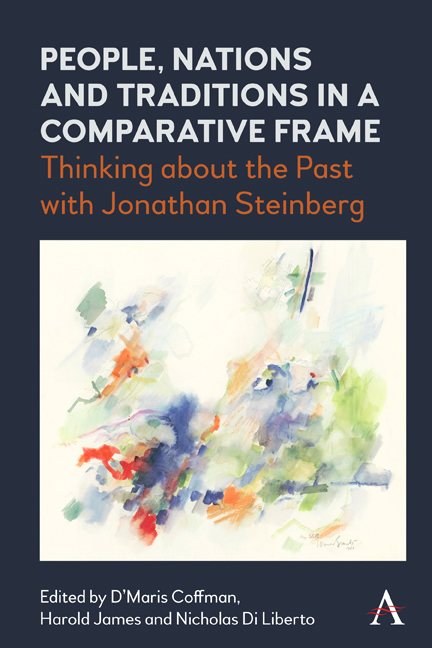 People, Nations and Traditions in a Comparative Frame
People, Nations and Traditions in a Comparative Frame Book contents
- Frontmatter
- Contents
- Foreword
- Acknowledgements
- Notes on Contributors
- Introduction
- Part One Methodological Pluralism and New Applications
- Part Two Personal and National Character
- Part Three Society, Families and the Sovereign Self
- Part Four History Out of Sync: Modernity and Tradition
- Part Five History, Narrative and the Human Condition
- Afterword
- Bibliography of Jonathan Steinberg’s Works
- Index
Chapter Fourteen - ‘Revolt Against the Modern World’: Religion and the Fascist Right in Contemporary Italy
Published online by Cambridge University Press: 23 February 2022
- Frontmatter
- Contents
- Foreword
- Acknowledgements
- Notes on Contributors
- Introduction
- Part One Methodological Pluralism and New Applications
- Part Two Personal and National Character
- Part Three Society, Families and the Sovereign Self
- Part Four History Out of Sync: Modernity and Tradition
- Part Five History, Narrative and the Human Condition
- Afterword
- Bibliography of Jonathan Steinberg’s Works
- Index
Summary
Introduction
Jonathan Steinberg was largely responsible for persuading Cambridge University Press to publish my first book, The Vatican and Italian Fascism, 1929–1932: A Study in Conflict. I began researching it as a PhD thesis in Rome in the 1970s; so when I was awarded the Balsdon Fellowship of the British School at Rome in 2013, I decided to revisit the subject matter of the thesis by undertaking research on ‘religion and the fascist right in contemporary Italy’.
For Italy, 2013 was a decisive year. In the general elections of February, the Five Star Movement of Beppe Grillo took its place in parliament for the first time, and the conclave of March elected the first non-European pope for many centuries, the Argentinian Jorge Bergoglio, who took the name of Francis I and embarked upon a reforming agenda in the Vatican. Italy was, once again, ‘in transition’.
There have been studies of specific Italian parties and groups, or the response of these parties and groups in public debates on issues of relevance to religious beliefs – like voluntary euthanasia, bio-ethics and same-sex marriage. My research sought to analyse more broadly the relationships between religion and groups on the fascist right within a historical perspective, focusing on the following questions:
1. How similar/different was the relationship between the Catholic Church and fascist groups in 2013 and that of the early 1930s?
2. What areas of broad agreement existed between fascist groups and the Catholic right in 2013?
3. What impact have exogenous factors had on the relationships between religion and the fascist right?
By way of a preamble, I examined relations between religion and the parliamentary, or ‘respectable’, non-fascist right, including the Lega (the Leagues), Forza Italia! (literally Forward Italy!) and the so-called ‘post-fascist’ right, like La Destra (the Right) and the Centro–Destra Nazionale (National Centre–Right), which is now called Fratelli D’Italia (Brothers of Italy), has been presented. This was necessitated by the fact that the centre to far right of the Italian political spectrum is very much a continuum, with substantial cultural and ideological overlaps between the various groups as far as attitudes to religion are concerned. Unless one examines the full range of the continuum, it is impossible to fully understand the cultures and ideologies underpinning the fascist right.
- Type
- Chapter
- Information
- People, Nations and Traditions in a Comparative FrameThinking about the Past with Jonathan Steinberg, pp. 203 - 222Publisher: Anthem PressPrint publication year: 2021


